
13 minute read
Chefs’ Tips and Tricks
CHEF’S TIPS & TRICKS
Taking Comfort
Advertisement
BY KEANE STRAUB I PHOTOGRAPHY BY DONG KIM
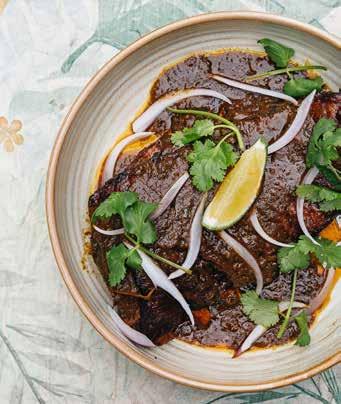
INTER IS A TIME FOR dormancy, for taking our time to just breathe, and tuck into W warm plates of nourishing food for the body and soul.
These comforting dishes can come in many forms, from many places and backgrounds, as we discovered in this month’s Chef’s Tips.
Four chefs from Calgary and Edmonton share with us what motivates them during the winter, how we can stay inspired to cook, and the delicious result of slowing down and allowing ourselves a little comfort as the New
Year unfolds.
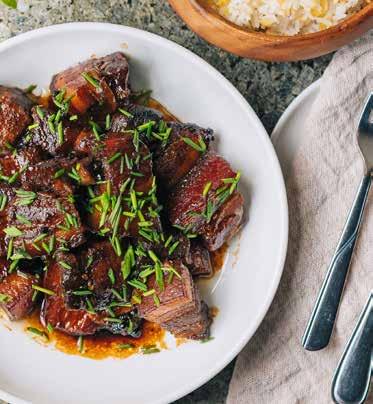
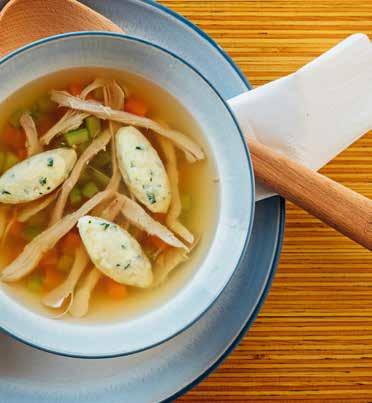
A1 Bodega & Café’s Executive Chef Mharlon Atienza says that being part of the opening team of two restaurants, and working alongside other chefs, instilled in him the value of hard work, dedication, and sacrifice. “These are lessons I have carried forward in my career as a chef, but also translate into my personal life making me the teacher, husband, and father I am today.”
Calgary born and raised, Atienza says that finding fresh ingredients during the winter is a challenge, so he hits up one of Calgary’s farmers markets. “There, you can find offerings from a lot of small greenhouses in Alberta that are operating year-round.”
During winter Atienza craves comfort, and “the stick-to-your-ribs type of cooking like Mom’s pork belly adobo.” Served with sinangag, or garlic fried rice, this is one dish that is simple to make, slow to simmer, and oh so savoury.

Pork Belly Adobo with Sinangag (garlic fried rice) Serves 2-4
850 g pork belly (skin on or off) 3 whole garlic cloves, peeled ½ cup (125 mL) gluten-free soy sauce 2 cups (500 mL) water 4 bay leaves 1 Tbs black peppercorns Thai or Serrano chili (optional) ¼ cup (60 mL) vinegar To taste salt To taste raw sugar 2-3 scallions, sliced thinly (garnish) 1. Cut pork belly into 2 cm cubes and place into Ziploc bag or spill-proof container. 2. Crush garlic cloves, add them and soy sauce to bag with pork belly. Seal and refrigerate, allowing to marinate for at least an hour. 3. In a large pot add water, bay leaves, and black peppercorn (use cheesecloth or a tea steeper to make removal easier). Simmer for 10 minutes. Remove peppercorns and bay leaves from water and discard. 4. Remove pork belly from marinade and transfer to paper towel. Reserve the marinade. 5. Bring the flavoured water to a boil. Add pork belly and cook for 5 minutes, skimming off any foam that comes to the surface. 6. Add the leftover marinade and Thai/ serrano chili if you like it spicy. Simmer for one hour, or until tender. 7. Add vinegar and simmer for another 15 minutes. If you like a thicker sauce, simmer until the liquid forms a nice sheen and is thick and glossy. 8. Taste and add sugar and salt to your liking. Garnish with thinly sliced scallions.
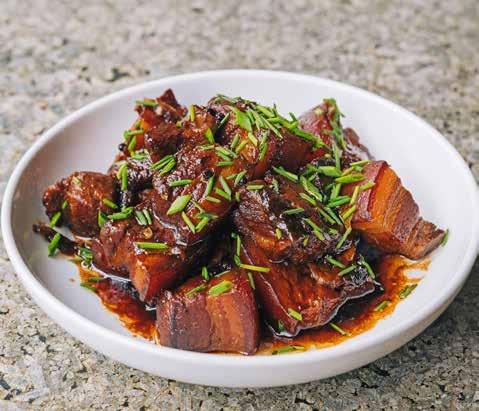
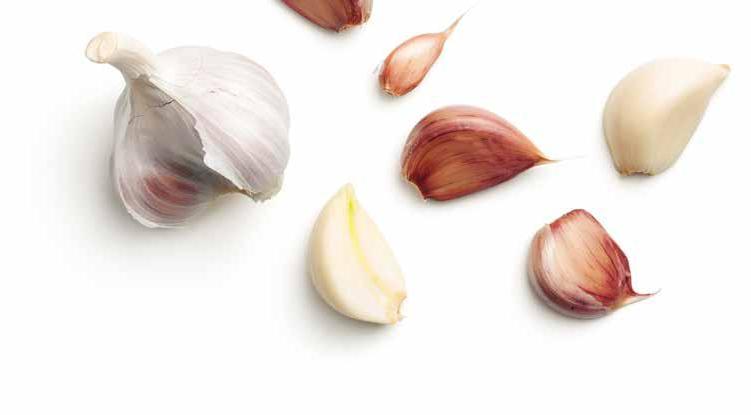
Sinangag (garlic fried rice) Serves 2-4
2-4 cups cooked, day-old rice ¼ cup (60 mL) canola oil, or any neutral cooking oil 1 head garlic, peeled and minced or crushed To taste salt To taste sugar
1. In a mixing bowl, gently break up dayold rice until there are no clumps. 2. Add canola oil to non-stick wok or pan and heat on medium heat. Add garlic and fry, keeping a close eye on it. It should be golden brown, but not burned. Once garlic is golden brown, remove from oil and set aside. 3. Add rice to oil and sauté. The goal is to heat the rice through, and get some of it crispy without burning. 4. Once the rice is heated through, add back the browned garlic, and season with salt and sugar.

Amit Bangar’s experience as Executive Chef at Calgary’s Calcutta Cricket Club is one that has brought him closer to his own culture and heritage. “[It’s] helped me create my own identity through food,” says Bangar.
Bangar points out that winter is a great time for seafood. “Colder waters can lend to many varieties of fish, crustaceans and shellfish to be a little fattier, and packed with amazing flavours.”
Stocks are at the top of Bangar’s winter cooking list. “A really good stock is easy to throw together and can go a long way.” Gradually filling the home with a warm aroma while cooking is an added bonus, something that is certainly achieved with Bangar’s recipe for braised lamb rib vindaloo.
Braised Lamb Rib Vindaloo Serves 2-4 2 racks lamb ribs
Spice Rub 4 dried sanaam chilies 3½ tsp whole cumin seeds 2 tsp white poppy seeds 20 whole cloves 1 tsp black peppercorn 10 cloves of garlic, peeled 20 g fresh ginger 1 whole green chili, chopped 7 Tbs (105 mL) white vinegar 1 Tbs (15 mL) tamarind paste 2 Tbs salt ¼ cup (60 mL) mustard oil 1 cinnamon stick 2 tsp yellow mustard seed 1 large red onion, thinly sliced 1 tsp turmeric 1½ tsp red chili powder 1 Tbs sugar 1 stem curry leaves 2 Tbs (30 mL) ghee (optional)
Note: Ground spices may be substituted for whole spices at a 1:1 ratio. For whole cloves, substitute ½ tsp ground cloves. If using ground spices, toast lightly in a dry pan before use.
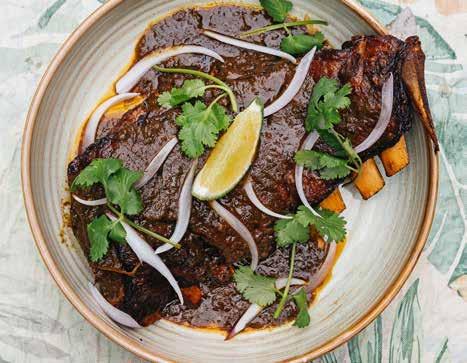
1 lime, for garnish Fresh chopped cilantro, for garnish Thinly sliced onion, for garnish
1. In a pan, toast the sanaam chilli, cumin, poppy, seeds, cloves, and peppercorns together over medium-low heat, constantly moving the spices to ensure they don’t burn. Set aside to cool, then grind with a mortar and pestle. 2. Once all spices are finely ground, add garlic, ginger, and green chilli to the mortar, crushing into a fine paste. Add tamarind paste and vinegar and mix all together. 3. Pat down the lamb ribs with a paper towel to remove excess moisture. In a mixing bowl, rub spice paste onto the lamb ribs, fully coating with all of the marinade. Cover, and leave in the fridge overnight. 4. Preheat oven to 325° F 5. Add mustard oil to a wide, heavy bottom pot or Dutch oven, and add cinnamon stick and yellow mustard seeds. Set heat to medium, and slowly temper the oil until the mustard seeds start to sputter. 6. Add sliced onions, turn up the heat and begin to caramelize, making sure not to burn. If the onions start to stick and turn dark on the bottom, add in a bit of water, and continue to cook, stirring occasionally. 7. Once caramelized, add turmeric, red chilli powder, sugar and curry leaves to the onions, and mix well. 8. Add one cup of water to deglaze pan, scraping with a wooden spoon to lift off any bits that stuck on the bottom of the pot. 9. Add lamb ribs with all of the marinade to the pot, and stir gently. Add enough water to just cover ribs. 10. Turn the heat up until just before the liquid comes to a boil. Cover with a lid, or use foil to create a tight seal. Place in the oven for about 3½ hours. 11. Once cooked, remove from oven and allow to rest for about an hour. 12. After resting, gently pull the lamb out and set aside. Using a blender/stick blender, puree the braising liquid to desired smoothness, or leave it as is, if you prefer it chunkier. 13. Cook down braising liquid until a rich curry sauce is formed. Add a touch of ghee if desired, and salt to taste. 14. Add lamb back to finished vindaloo sauce, and warm through. 15. Plate lamb ribs on a serving platter, and garnish with cilantro, onion slices and lime.
Note: If you don’t have a mortar and pestle, use a spice/coffee grinder, or create a makeshift mortar and pestle with a large, heavy Ziploc bag (make sure there is no air in the bag when sealed), and a crushing implement (a rolling pin, or an empty wine bottle works great – be sure to use the bottom surface when grinding).

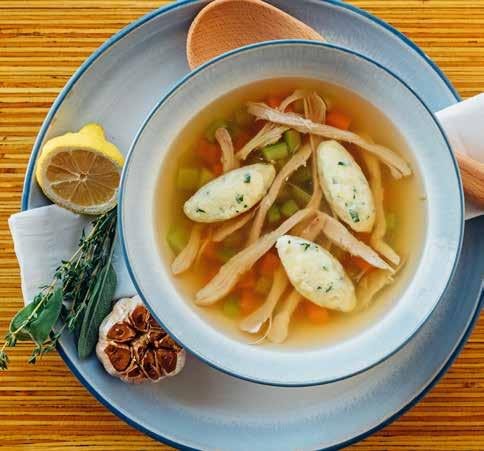
Cold weather does little to diminish Holly Holt’s inspiration – the Sous Chef of Edmonton’s OTTO Food and Beverage loves cooking during the winter months. “It’s the best time to curl up on the couch, read a cookbook, have a glass of wine, and brainstorm recipes and meal plans,” she explains.
Holt also frequents The Italian Centre Shop, and Asian supermarkets, and takes advantage of local walleye, thanks to her brother, an avid ice fisher. “If you’re able to sustainably source Alberta’s lake fish, I highly recommend doing so.”
And of course, we can all use a bit of warming up when we come in from the cold. “When we think of cold weather food, we think comfort,” says Holt, and Drop dumpling batter her ‘Heart’y Chicken and Drop Dumpling ¼ cup unsalted butter Soup is especially good for the soul. ½ cup (120 mL) water ½ cup all-purpose flour Generous pinch of salt Heart’y Chicken and 2 eggs Drop Dumpling Soup Serves 3-4 1. Season the chicken all over with a sprinkle of salt and pepper Soup 2. Heat oil in heavy-bottomed pot. Add 1 whole chicken, preferably locally chicken and cook until lightly browned. sourced, quartered 3. Add in carrot, celery, and onion, and To taste salt and pepper cook until onions are just translucent. 2 Tbs (30 mL) canola oil 4. Reduce heat to low, add garlic, cook 1 large carrot, diced until fragrant. 1-2 celery stalks, diced 5. Add a pinch of salt and pepper, and all 1 large yellow onion, diced herbs except parsley. Add enough water 3 cloves garlic, roughly chopped to cover chicken. Cover with lid, and 1 stem fresh rosemary, stem removed, simmer on low for 1 hour. roughly chopped 6. If using chicken hearts, prepare by 2 sprigs fresh thyme, stem removed, removing ventricles, and any fatty bits as roughly chopped best you can, and set aside. 1 bay leaf 7. Prepare your drop dumplings: in a 10 chicken hearts, optional (you can usually small pot, bring butter and water to a find these at your local grocery store) simmer. Remove from heat, add flour ¾ cup fresh flat leaf parsley leaves, and salt, and using a wooden spoon stir roughly chopped vigorously. Let mixture cool until it no Zest and juice of 1 lemon longer steams. 8. Add eggs as slowly as possible (to avoid scrambling) while still mixing with wooden spoon. Dough should be shiny and smooth. Add some of the parsley to batter if you like. Set aside. 9. Taste soup, add salt to taste. Shred chicken meat from bone, remove bone and discard. 10. If you’ve lost a lot of liquid, you may want to add more water at this point. Bring back to a simmer. If using chicken hearts, add them at this point. 11. Drop dumpling batter by the spoonful into the hot broth as quickly as possible – use two spoons to achieve best results, one to scoop dough, and the other to scrape the dough off to drop into broth. Dumplings take about 3 minutes to cook, and will float on the surface when done. 12. Turn off heat, add parsley, lemon, and salt and pepper to taste.
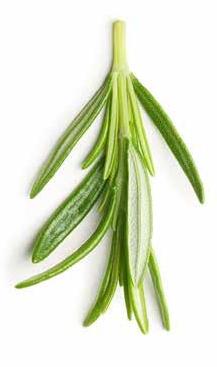
Note: This soup freezes very well if there are leftovers!
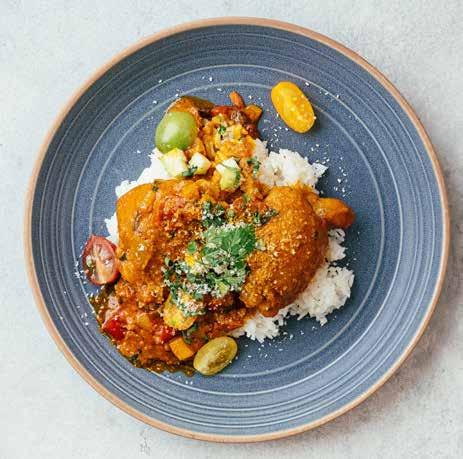
Chef Eric Mah says the most memorable experiences of his career – presenting a dinner on a beach in Aruba, and staging in a restaurant in Romania – were stops along the way to coming full circle to work alongside his mentor as the Executive Chef and Co-Owner of Calgary’s Purlieu.
For Mah, inspiration can come from something he sees on TV, a request from his wife, or “wanting to test something weird that popped into my head.” And, if you’re feeling less inspired by what you can find at the grocery store, Mah says to consider what the Western provinces can offer, such as apples, pears, and broccoli. “We also have great farms in Alberta for pork, chicken, lamb, and obviously beef.”
Mah attributes the flavours he explores to his training in the Caribbean and Asian heritage, and tends to complement both of those elements. “Just a smell or taste can bring back memories of warmer, distant places.” Mah’s recipe for Moroccan Curry Chicken is sure to deliver.

Moroccan Curry Chicken Serves 4
1 Tbs ground cumin ½ Tbs ground coriander 1 Tbs turmeric powder 1 Tbs paprika ½ tsp ground cinnamon 1 tsp chili powder 8 chicken thighs, skin on To taste salt and pepper 2 Tbs (30 mL) canola oil 1 yellow onion, finely diced 2 Tbs fresh ginger, peeled and finely chopped 4 cloves garlic, finely chopped 1 cup (250 mL) water 1 can (398 mL) coconut milk 1 can (398 mL) crushed tomatoes 2 bay leaves ½ Granny Smith apple, peeled and finely diced ½ bunch cilantro, stems removed and finely chopped
1. Mix together cumin, coriander, turmeric, paprika, cinnamon, and chili powder, set aside. 2. Season chicken thighs with salt and pepper, and set aside. Add canola oil to a deep pot and heat until almost smoking. Add chicken thighs, skin-side down. Brown the skin, then flip and sear the other side. Once both sides are browned, remove and set aside. 3. To the heated pot, add onion, ginger, and garlic. Sauté for two minutes, until onions become slightly translucent. Reduce heat to medium, and add spice mixture. Stir constantly for about two minutes, until spices are cooked and fragrant. 4. Add water to pot to deglaze, making sure to scrape all the bits from the bottom of the pot. Add coconut milk, tomatoes, and bay leaves, and stir to incorporate. 5. Add chicken thighs back in, side by side to fit snugly in the pot (try not to stack them if you can avoid it). The chicken should be submerged in the liquid. 6. Cover pot with lid and reduce heat to medium-low. Simmer for about 20 minutes to finish cooking the chicken thighs. 7. Remove lid and add diced apples. Cook for another 5 minutes to further reduce sauce. Check for seasoning, adding salt and pepper to taste. 8. To finish, add chopped, fresh cilantro and serve over steamed rice, or your favourite starch.

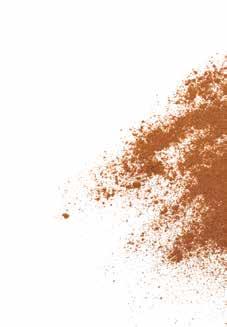
Note: Try adding raisins, dried apricots, slivered almonds, or whatever inspires you, to this dish – play around with it to find the flavours you like!
Keane Straub has travelled from Tofino to Charlottetown, sampling the different flavours Canada offers. The passion people have for their craft and culture inspires Keane to tell their stories.










